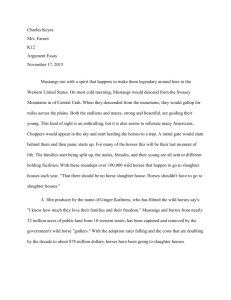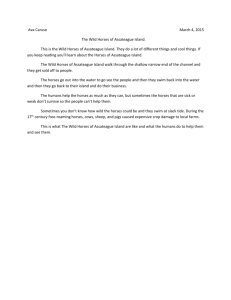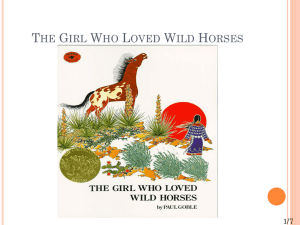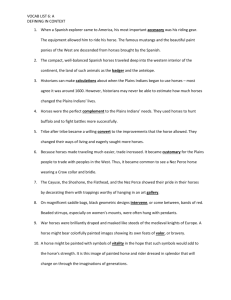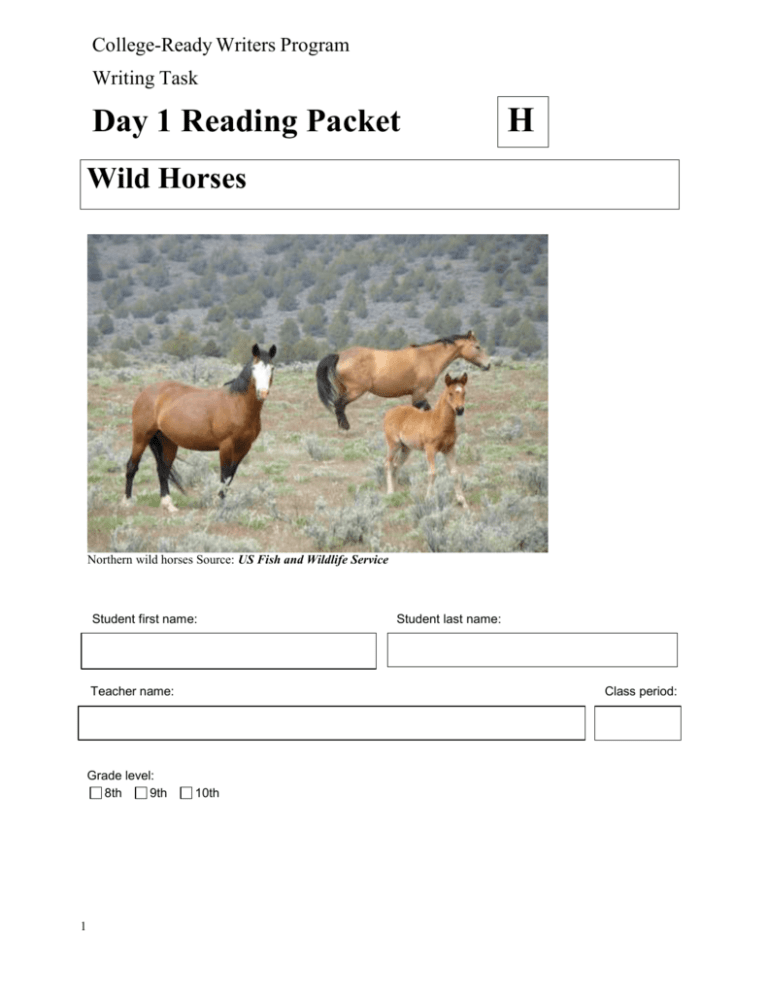
College-Ready Writers Program
Writing Task
Day 1 Reading Packet
H
Wild Horses
Northern wild horses Source: US Fish and Wildlife Service
Student first name:
Teacher name:
Grade level:
8th
9th
1
Student last name:
Class period:
10th
PROMPT FOR WRITING
H. Wild Horses
Wild horses have become a subject of debate. Wild horses are protected by law, and
yet the number of horses has increased so much that they cannot get enough to eat on
public land. What do you think the Bureau of Land Management should do about the
challenge of managing wild horses? Why?
Write an argument. Use ideas and evidence from the reading packet to support your
argument. Use what you have learned about citing and quoting sources in your
writing
The audience for your argument is the Director of the Bureau of Land Management.
DIRECTIONS
This packet is part of a two-day writing task.
Today you will analyze the readings to learn about different opinions on this topic. On
Day 2, you will write an argument that supports your opinion in response to the prompt
above.
Use the space provided in the margins to take notes on the readings.
On pp. 14-15, you will find definitions for vocabulary words. These words are
italicized in the text.
Use the space on p. 16 to plan your argument for Day 2.
2
Use margin to take notes
Reading 1
Introduction
Meeting of National Wild Horse and Burro
Advisory Board
The National Wild Horse and Burro Advisory Board will meet
for two days in Sacramento, California, to discuss the
management and protection of wild horses and burros on
Western public rangelands. The Advisory Board provides
advice to the U. S. Bureau of Land Management (BLM) on
how to manage the increasing numbers of wild horses.
The 1971 Wild Free-Roaming Horses and Burros Act requires
that the government manage the herds of wild horses so that
the horses are healthy and so that the size of the herds is in
keeping with the land’s capacity to support them. At this time,
about 40,600 wild horses roam lands in 10 Western states.
The BLM is asking veterinarians, scientists, universities, and
the public for advice on how to best keep the numbers of
horses from growing too rapidly—because the lands cannot
support larger herds. The deadline for submitting a written
plan for wild horses is July 1, 2015.
Source: U. S. National Wild Horse and Burro Advisory Board. Bureau of
Land Management. March 22, 2014. Posted by KCSG Television
3
Use margin to take notes
Reading 2
Debate Grows Over Roundup of Wild
Horses in Nevada
By Randal C. Archibold
December 31, 2009
The federal Bureau of Land Management this week began its
“gather” of about 2,500 wild horses in . . . Nevada. Balancing
natural resources is the goal.
With helicopters swooping low and slow, wranglers this week
began rounding up wild horses on a vast Nevada range,
feeding an intense debate over whether removing the animals
helps or hurts the preservation of an enduring symbol of the
West. . . .
There are too many of the animals in that area, upsetting the
balance of natural resources for flora and fauna, including
grazing land for cattle, federal officials said. About 140 horses
had been removed as of Thursday. After two months of
rounding them up and eventually trucking most to pastures in
the Midwest, government officials expect 600 to 800 horses
will remain.
“The fact is right now we have three to five times the
population of wild horses that the range can sustain,” said Bob
Abbey, director of the federal Bureau of Land Management….
Horse advocates unsuccessfully sued to block this roundup. . .
. Suzanne Roy, of In Defense of Animals, . . . says the horses
should be allowed to stay put. “Wild horses have tightly knit
bands,” Ms. Roy said. “This shatters the social structure; foals
are separated from their mothers; the horses are put in a very
unnatural situation. The whole thing is just a major trauma and
terror for these really beautiful horses that have lived
peacefully on these lands for hundreds of years.”
But the land management bureau said the “gather,” as it calls
it, would ultimately save the lives of horses.
Unlike other animals, wild horses cannot legally be hunted or
slaughtered, and they have no natural predator. When the area
gets overpopulated, food becomes scarce and the horses suffer,
said Mr. Abbey, the agency director, who expressed
exasperation with some animal rights advocates. “If it were up
to them, we would be allowing wild horses to starve to death,
which is no way to honor an American icon,” he said in a
telephone interview.
4
Most of the older animals are moved to distant pastures that
provide lots of room and abundant food. The younger horses
are put up for adoption. . . .
A goal of the roundup . . . was providing access to grazing
land for cattle. Some ranchers have pulled cattle from pockets
of the range because there has not been enough vegetation,
partly because of the overpopulation of horses but also
because of a lingering drought.
Bureau officials said the roundups include safeguards, like a
check of the horses by veterinarians. Since Monday, one horse
caught in the roundup had to be euthanized because, Mr.
Abbey said, it would not have survived the winter because of
its advanced age. . . .
The government already keeps 34,000 wild horses and burros
captive, mainly in Oklahoma and Kansas. Another 37,000,
half in Nevada, roam on bureau territory in 10 states.
Source: New York Times. December 31, 2009. A version of this article
appeared in print on January 1, 2010, on page A17 of the New York
edition.
About the author: Randal C. Archibold is the New York Times bureau
chief for Mexico, Central America and the Caribbean. Before beginning his
assignment there, he covered a large swath of the southwestern United
States.
5
Use margin to take notes
Use margin to take notes
Reading 3
Living with Wild Horses
By Steve Louis
Wild horses roaming outside of their herd management areas
have caused vehicle accidents, personal injury, and property
damage. Additionally, wild horses can spread disease to
domestic horses. In the three-year period from 1997 to 2000,
93 vehicular accidents were horse related and resulted in 25
personal injuries in six western Nevada counties.
Damage to landscape, fencing, irrigation equipment and other
property, has resulted from wild horses wandering into
residential neighborhoods.
The Law
In 1971 The U.S. Congress passed the Wild Horse and Burro
Act. This created laws which call for; wild horses to be
managed so ecosystems can thrive. . . . In addition to federal
law, Nevada law states it is illegal to feed or provide water to
wild horses. This practice lures them away from their herd
management area and onto private property. It desensitizes
horses to people and the urban landscape. Horses found
outside their management area are subject to capture by the
land management agency.
Feeding is not only illegal it can cause serious health
problems. Diet change can cause stomach disorders and
possibly death in any horse, wild or domestic. Moldy, weedy
hay and even good hay can cause serious health problems.
Keep Them Off Private Property!
Neighborhood residents can use some of the following ideas to
help keep wild horses off private property. In areas designated
“Open Range”, private property owners are required by law to
fence out livestock and wild horses…. In some instances the
land management agency may be willing to work with a
volunteer group of committed citizens. This group of
horsemen would be responsible for moving wild horses back
into their management area. Members of the posse would be
trained by agency experts to insure they worked within the
law. . . .
Source: Louis, Steve. “Living with Wild Horses. ”University of Nevada,
Reno, Cooperative Extension Service. Fact sheet-01-36.Web. 28 March
2014.
About the author: Steve Louis is an extension educator at the University of
Nevada Cooperative Extension Service.
6
Reading 4
Wild Horses and the Ecosystem
By American Wild Horse Preservation Campaign
The Wild Free-Roaming Horse and Burro Act recognizes the
wild horse as an "integral component of the natural system." It
stipulates that horses can only be removed from public lands if
it is proven that they are overpopulating or are causing habitat
destruction. … The Bureau of Land Management (BLM) has
never presented any evidence that horses destroy habitat, nor
that their population levels are what it claims they are. . . .In
stark contrast with BLM’s assertions, scientific studies have
shown that horses actually benefit their environment in
numerous ways. . . .
Cows have no upper front teeth, only a thick pad: they graze
by wrapping their long tongues around grass and pulling on it.
If the ground is wet, they will pull out the grass by the roots,
preventing it from growing back. Horses have both upper and
lower incisors and graze by "clipping the grass," similar to a
lawn mower, allowing the grass to easily grow back.
In addition, the horse’s digestive system does not thoroughly
degrade the vegetation it eats. As a result, it tends to “replant”
its own forage with the diverse seeds that pass through its
system undegraded. This unique digestive system greatly aids
in the building up of the absorptive, nutrient-rich humus
component of soils. This, in turn, helps the soil absorb and
retain water upon which many diverse plants and animals
depend. In this way, the wild horse is also of great value in
reducing dry inflammable vegetation in fire-prone areas. Their
tendency to range widely throughout both steep, hilly terrain
and lower, more level areas, while cattle concentrate on lower
elevations, also explains why horses have a lesser impact on
their environment than livestock: their grazing habits cause
horses to nibble and then move to the next bunch of grass.
This is why horse range is seldom denuded. . . .
Wild horses should not be used as scapegoats for range
degradation that is in fact primarily caused by private
livestock: for instance, environmentalists have determined that
in Nevada, home of the vast majority of America's remaining
wild horses, the herds have little impact on the ecosystem
compared with the hundreds of thousands of cattle that also
roam the Nevada range. The Western Watersheds Project
acknowledges that "the main cause of degradation of public
lands in the arid west is livestock use and not wild horses."
7
Use margin to take notes
Source: ”Wild Horses and the Ecosystem.” American Wild Horse
Preservation Campaign. All rights reserved. © 2004-2013. Web. 28 March
2014.
Reproduction authorized solely for educational purposes.
About the author: The American Wild Horse Preservation Campaign
(AWHPC) is dedicated to preserving American wild horses and burros in
viable free-roaming herds for generations to come, as part of our national
heritage.
8
Use margin to take notes
Use margin to take notes
Reading 5
Report Criticizes U.S. Stewardship of Wild
Horses
By Dan Frosch
Published: June 6, 2013
DENVER — A new report catalogs a range of problems with
the way the federal government is managing thousands of wild
horses and burros. . . . It also said that the bureau’s policy of
removing the animals from the range and taking them to
holding facilities as a means of population control, an
approach that has drawn sharp criticism from wild horse
proponents, did not work. . . . “Compelling evidence exists
that there are more horses and burros on public rangelands
than reported at the national level and that population growth
rates are high.”
Wild horses . . . have been at the center of an increasingly
bitter dispute over the past several years. The bureau contends
that their numbers have become unmanageable. And it says it
has little choice but to bring them to enclosed pastures so that
other animals can share the land. Horse advocates counter that
the horses should be allowed to live freely.
The bureau estimates that about 37,300 wild horses and burros
roam on federally managed rangeland in 10 Western states and
that nearly 50,000 additional animals are being cared for at
short-term corrals and long-term pastures. With essentially no
natural predators, herds typically double every four years.
The National Academy of Sciences report found that the
bureau had most likely undercounted the horses by 10 to 50
percent. It also said that the bureau’s horse removals might
inadvertently allow the animal population to swell by reducing
competition for forage.
The report recommended that more fertility control drugs be
used as an alternative, a departure from the bureau’s current
approach. “It needs to be used in a consistent, widespread
manner, which has not been done today,” said Dr. Guy
Palmer, a veterinarian at Washington State University and the
chairman of the committee that conducted the study. . . .
“The report is a powerful validation of what wild horse
advocates have been saying for years,” said Suzanne Roy,
director of the American Wild Horse Preservation Campaign.
“The report delivers a strong case for an immediate halt to the
9
Use margin to take notes
roundup and removal of wild horses from the range, an
increase in wild horse and burro population levels and
implementation of in-the-wild management using available
fertility control options.”
BLM spokesman, Tom Gorey, said the bureau needed and
wanted to do a better job managing the animals, but was well
aware the program was in a “crisis” because it was running out
of holding space. Mr. Gorey also pointed out that because
fertility control treatments lasted only one to two years, some
horse removals would have to continue.
Leaving the population control to nature, he said, “would
subject horses and burros to mass starvation and dehydration,”
he said. “We don’t think that laissez-faire style is something
the American public or Congress would support.”. . .
Source: Frosch, Dan. “Report Critisizes U. S. Stewardship of Wild
Horses.” New York Times. New York Times, 6 June 2013. Web. 26 March
2014.
A version of this article appeared in print on June 7, 2013, on page A13 of
the New York edition with the headline: Report Criticizes Federal
Stewardship of Wild Horses.
About the author: Dan Frosch covers the Southwest for the New York
Times.
10
Use margin to take notes
Reading 6
Should We Protect Wild Horses?
By Chuck Klosterman, March 21, 2014
Question: In the United States, it’s illegal to kill a wild horse
on public lands. Yet wild horses can have destructive grazing
behavior, and indigenous grazers and browsers (deer, for
example) have to compete with them for land. . . Is it unethical
to protect wild horses? T.G., NEW YORK
Response: . . .Your argument is that wild horses hurt the
environment; I’d argue that wild horses have become part of
the environment itself. Horses alter the ecological landscape,
but we’d be altering the landscape by eliminating the horses.
If your point is that there’s a degree of hypocrisy in the human
relationship with horses, I [agree]. There are certain animals
humans tend to care about more than others, and it can seem
arbitrary. If your thoughts on animal rights exist at one of the
philosophical poles — if you believe no animal should ever be
killed, or if you believe any animal can be killed for any
reason — this question is easy. But most people are
somewhere in the middle, holding views that don’t always
make rational sense. For example, I find the extermination of
invasive pythons in Florida less unsettling than the
extermination of invasive Mustangs in Nevada. This is my
emotional reaction. But ethics forces people to consider things
that might contradict their feelings.
The Bureau of Land Management estimates there are about
33,780 wild horses on public U.S. rangeland. The optimal
population would be smaller by several thousand. Some may
argue that thinning the herd increases the quality of life for the
species as whole, which is true — assuming you’re not one of
the horses to be eliminated.
I would ultimately say this: It’s unethical to protect wild
horses (which are currently not categorized as endangered) if
our only reasoning is that we happen to like horses and believe
they deserve preferential treatment. Our policy and criteria for
horse populations should be the same as our policy for coyotes
or any other mammal. But none of these species should be
radically culled unless they pose a direct threat to human wellbeing, which does not appear to be the case. Now, if that
sounds as if I’m “privileging” human life over nonhuman life,
it’s because I am. I don’t think humans and nonhumans are
11
equal. But that doesn’t mean we can treat animals as bloodless
statistical populations that we control at our convenience.
Source: Klosterman, Chuck. “Should We Protect Wild Horses?” New York
Times. New York Times, 21 March 2014. Web. 28 March 2014.
About the author: Chuck Klosterman is full-time ethicist for the New
York Times who, as a writer, confronts all manner of thorny questions and
who isn’t afraid of expressing his opinions about how things are and How
They Should Be.
12
Use margin to take notes
Reading 7
2013 Number of Wild Horses & Burros in the U.S.
Compared to the
Number That U.S. Lands Can Support
Horses/Burros
U.S. TOTALS
Maximum Horses/Burros U.S.
Lands can Support
0
10,000
20,000
30,000
40,000
50,000
Number of Horses and Burros
Source: FY 2013 Wild Horse and Burro Herd Populations and Appropriate Management Levels
by State. U. S. Department of the Interior, Bureau of Land Management. 2013
Take notes below:
What do you notice about the number of horses and burros that the land can support compared to
the actual number them in the wild?
13
Use margin to take notes
Vocabulary
arbitrary: not planned or chosen for a particular reason or
evidence, done without concern for what is right
burro: a small donkey
U. S. Bureau of Land Management (BLM): The
government agency responsible for 8.7 million acres of
public lands in 10 Western States.
degrade: in digestion, to decompose or break down food.
(Seeds eaten by horses are undegraded (not broken down) as
they pass through the horse’s digestive system.)
denuded: stripped of grass
desensitize: to extinguish an emotional response such as fear
enduring symbol of the West: in this case, horses are
symbolic of the history of the West
ethicist: a person concerned with right and wrong
euthanized: to kill an animal painlessly to relieve suffering
fertility control: methods of inhibiting population growth in
animals through hormone implants, surgical procedures,
chemicals, or vaccines. In the U.S., reproductive inhibitors
for wildlife must undergo extensive federal review before
being approved. Contraceptives for wild and feral animals
are regulated by the Environmental Protection Agency.
Source: The Wildlife Society, Bethesda, MD.
tws@wildlife.org
forage: bulky food such as grass or hay
hypocrisy: pretending to have moral standards or beliefs that
one’s actions do not illustrate
indigenous: native; occurring naturally in a particular place
laissez-faire: French for “leave it be” or “let do;” an
environment of little to no regulation or interference by
government
Mustang: free-roaming (wild) horses of the west
optimal: best or most favorable
14
preferential: partiality; treating one person or species better
than others for no logical reason
wild horse proponents: people concerned about the wellbeing of wild horses
wranglers: a cowboy who controls horses
15
Use margin to take notes
Planning Your Argument
Wild horses have become a subject of debate. Wild horses are protected by law,
and yet the number of horses has increased so much that they cannot get enough to
eat on public land. What do you think the Bureau of Land Management should do
about the challenge of managing wild horses? Why?
Use this space to:
Write your claim.
Select and organize evidence from the readings that you will use to write
your argument on Day 2.
16


